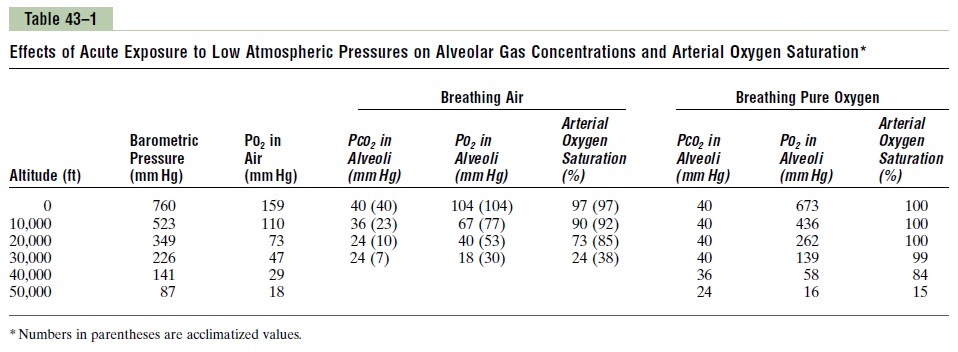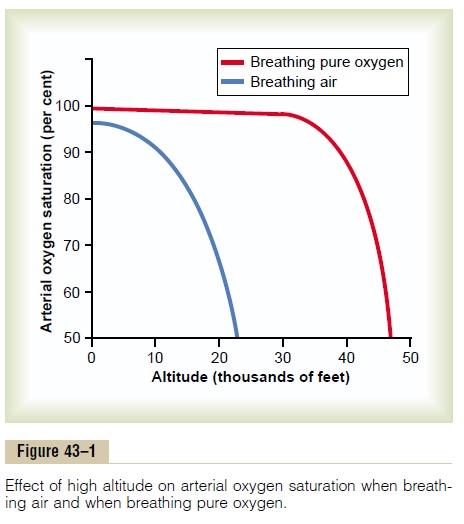Chapter: Medical Physiology: Aviation, High-Altitude, and Space Physiology
Alveolar PO2 at Different Elevations
Alveolar PO2 at Different Elevations
Carbon Dioxide and Water Vapor Decrease the Alveolar Oxygen. Even at high altitudes,carbon dioxide is continually excreted from the pulmonary blood into the alveoli. Also, water vaporizes into the inspired air from the respiratory surfaces. These two gases dilute the oxygen in the alveoli, thus reducing the oxygen con-centration. Water vapor pressure in the alveoli remains 47 mm Hg as long as the body temperature is normal, regardless of altitude.
In the case of carbon dioxide, during exposure to very high altitudes, the alve-olar PCO2 falls from the sea-level value of 40 mm Hg to lower values. In the acclimatized person, who increases his or her ventilation about fivefold, the PCO2falls to about 7 mm Hg because of increased respiration.
Now let us see how the pressures of these two gases affect the alveolar oxygen. For instance, assume that the barometric pressure falls from the normal sea-level value of 760 mm Hg to 253 mm Hg, which is the usual measured value at the top of 29,028–foot Mount Everest. Forty-seven millimeters of mercury of this must be water vapor, leaving only 206 mm Hg for all the other gases. In the acclimatized person, 7 mm of the 206 mm Hg must be carbon dioxide, leavingonly 199 mm Hg. If there were no use of oxygen by the body, one fifth of this 199 mm Hg would be oxygen and four fifths would be nitrogen; that is, the PO2 in the alveoli would be 40 mm Hg. However, some of this remaining alveolar oxygen is continually being absorbed into the blood, leaving about 35 mm Hg oxygen pressure in the alveoli. At the summit of Mount Everest, only the best of acclimatized people can barely survive when breathing air. But the effect is very different when the person is breathing pure oxygen, as we see in the fol-lowing discussions.

Alveolar PO2 at Different Altitudes. The fifth column of Table 43–1 shows the approximate PO2s in the alveoli at different altitudes when one is breathing air for both the unacclimatized and the acclimatized person. At sea level, the alveolar PO2 is 104 mm Hg; at 20,000 feet alti-tude, it falls to about 40 mm Hg in the unacclimatized person but only to 53 mm Hg in the acclimatized. The difference between these two is that alveolar ventila-tion increases much more in the acclimatized person than in the unacclimatized person, as we discuss later.
Saturation of Hemoglobin with Oxygen at Different Altitudes. Figure 43–1 shows arterial blood oxygen saturation at different altitudes while a person is breathing air and while breathing oxygen. Up to an altitude of about 10,000 feet, even when air is breathed, the arterial oxygen saturation remains at least as high as 90 per cent. Above 10,000 feet, the arterial oxygen saturation falls rapidly, as shown by the blue curve of the figure, until it is slightly less than 70 per cent at 20,000 feet and much less at still higher altitudes.

Related Topics